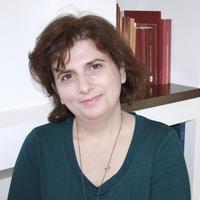Christina Tsigonaki
University of Crete, History and Archaeology, Faculty Member
- Byzantine Archaeology, Landscape Archaeology, Urbanism (Archaeology), Roman Marble trade and distribution, Late Antique Archaeology, Late Roman Pottery, and 39 moreLate Roman and early Byzantine fortifications, Byzantine Architecture, History and archaeology, Byzantine Studies, Settlement Patterns, Byzantine History, Hagiography, Late Roman Empire, Late Antiquity, History of Archaeology, Greek (Byzantine) Texts, Early Byzantine Archaeology, Early Christian Architecture, Christian Archaeology, Byzantine church, Early Byzantine pottery, Corpus Ponderum Antiquorum Et Islamicorum, Byzantine Epigraphy, Late Antique Art and Archaeology, Byzantine Architectural Sculpture, Late Antique and Byzantine Studies, THESSALONIKI, Spolia, Byzantine history and archaeology, Late Antique and Byzantine History, Byzantine Pottery, Peloponnese in the Middle Ages, Archaeology of Crete, Late Roman and Early Byzantine Pottery, Mediterranean archaeology, Historical Archaeology, Historical Geography, Early Christian Archaeology, Archaeological survey, Insularity, Maritime Archaeology, Maritime Routes, Ancient Shipwrecks, and Islandsedit
Research Interests:
Research Interests:
This article briefly presents the results of the archaeological excavations of the years 2013-2016 on the Central Plateau of the Acropolis of Eleutherna. It is the continuation of the account of the results published in Πρακτικά του... more
This article briefly presents the results of the archaeological excavations
of the years 2013-2016 on the Central Plateau of the Acropolis of
Eleutherna. It is the continuation of the account of the results published
in Πρακτικά του Αρχαιολογικού Έργου Κρήτης 3. The article is divided into three parts, according to where the excavation was focused:
a. The Byzantine Quarter (southern sector) – Roman bath. On the
southern part of the Central Plateau architectural structures related
to the Byzantine district of the 7th and 8th centuries were revealed.
As evident from the work of previous years, the Byzantine buildings
were built on the ruins of a public bath of Roman times. The account
examines in detail the buildings discovered east of a road running
parallel to that of the fortification wall on the east slope. Where excavation went deep enough, areas of the bath were discovered (such as an area with a hypocaust).
b. Christian church. Excavation continued with the investigation of the
surrounding area of the church on the Central Plateau: east of the
apse of the sanctuary, where under an extensive layer of destruction
a burial of importance was found.
c. The enclosing fortifications. The trials made at the base of wall on the
east slope revealed that the fortifications of the early Byzantine period
were set directly on the natural bedrock. No foundation trench was
found. The western slope of the Acropolis was extensively cleaned to
document the fortification located on a lower terrace just below the
excavated area of the Central Plateau. Part of a fortified enclosure
about 50 m long was discovered, in which two construction phases
can be clearly distinguished: one probably of the Hellenistic period
and one of the early Byzantine period.
A particularly important numismatic find is presented in a separate
section. This is an early Islamic fals, minted in Egypt in the first decades
of the 8th century. Thus, it dates back to before the Arab conquest of
Crete. This is one of only a few examples of 8th century Arabic issues
found on the island, and the only one found during a systematic excavation.
of the years 2013-2016 on the Central Plateau of the Acropolis of
Eleutherna. It is the continuation of the account of the results published
in Πρακτικά του Αρχαιολογικού Έργου Κρήτης 3. The article is divided into three parts, according to where the excavation was focused:
a. The Byzantine Quarter (southern sector) – Roman bath. On the
southern part of the Central Plateau architectural structures related
to the Byzantine district of the 7th and 8th centuries were revealed.
As evident from the work of previous years, the Byzantine buildings
were built on the ruins of a public bath of Roman times. The account
examines in detail the buildings discovered east of a road running
parallel to that of the fortification wall on the east slope. Where excavation went deep enough, areas of the bath were discovered (such as an area with a hypocaust).
b. Christian church. Excavation continued with the investigation of the
surrounding area of the church on the Central Plateau: east of the
apse of the sanctuary, where under an extensive layer of destruction
a burial of importance was found.
c. The enclosing fortifications. The trials made at the base of wall on the
east slope revealed that the fortifications of the early Byzantine period
were set directly on the natural bedrock. No foundation trench was
found. The western slope of the Acropolis was extensively cleaned to
document the fortification located on a lower terrace just below the
excavated area of the Central Plateau. Part of a fortified enclosure
about 50 m long was discovered, in which two construction phases
can be clearly distinguished: one probably of the Hellenistic period
and one of the early Byzantine period.
A particularly important numismatic find is presented in a separate
section. This is an early Islamic fals, minted in Egypt in the first decades
of the 8th century. Thus, it dates back to before the Arab conquest of
Crete. This is one of only a few examples of 8th century Arabic issues
found on the island, and the only one found during a systematic excavation.
Research Interests:
Research Interests:
Research Interests:
Research Interests:
Research Interests:
Research Interests:
Research Interests:
Research Interests:
Research Interests:
Research Interests:
Research Interests:
Η Ελεύθερνα και οι Άραβες: με αφορμή ένα νομισματικό εύρημα από τις ανασκαφές του Τομέα ΙΙ στο Πυργί, Η Ελεύθερνα, η Κρήτη και ο έξω κόσμος, Διεθνές αρχαιολογικό συνέδριο, Ρέθυμνο, 31 Μαΐου – 2 Ιουνίου 2018
Research Interests:
Towns and country in Crete during a period of insecurity (7th – 8th centuries), International Medieval Conference, Town and Country in the Byzantine World: Social and Economic Perspectives, American Research Center in Sofia, May 7-8 2015
